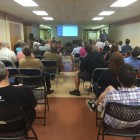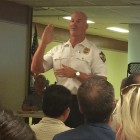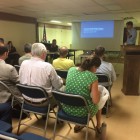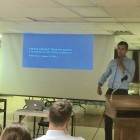A nascent proposal to improve safety on Lenox Avenue by re-routing traffic through area side streets appears to be a non-starter.
Residents of the neighborhood centered around Lenox Avenue in South Orange showed up in force at a meeting Wednesday night at The Baird to discuss options for improving safety along Lenox Avenue at the Wyoming, S. Ridgewood and Walton intersections.
The potential proposal to re-route traffic from Lenox Avenue onto Lenox Terrace, Lenox Place, Thornden Street and Cedar Lane involving properties in South Orange and Maplewood — referred to in shorthand as “the bisection”— was at the center of discussion.
Judging by email and online comments in the 24 hours prior to the meeting, the forum promised to be heated. However, although passionate feelings were evident, those running the meeting as well as attendees resisted any urges toward anger and name-calling and kept the conversation civil and constructive.
The first hour of the meeting involved a presentation by three Lenox Avenue area residents who have been working with the South Orange Transportation Advisory Committee as they measured and researched traffic patterns, speed, volume and accident statistics on the street.
Ron Charles presented on behalf of the group.
Charles helped to diffuse tensions by repeatedly stating throughout his presentation that no option for improving safety along Lenox Avenue had been either officially presented or adopted.
“This is not an official presentation,” Charles said at one point. He also stressed that the meeting was to encourage “open discussion” and “have your voices heard” and that “we’re still early in this process” and “nothing, absolutely nothing is imminent whatsoever.”
After explaining that there had been 47 accidents at the three Lenox Avenue intersections since 2005 (22 at Wyoming, 19 at S. Ridgewood and six at Walton), Charles detailed a number of efforts to obtain data concerning the intersections, including setting up cameras at each intersection for 13 consecutive hours on September 17, 2015 — a Thursday and not a holiday (in answer to a question later in the meeting, Charles noted that there were no nearby street closures that day due to ongoing water system work).
Charles also took the audience through a number of potential traffic calming solutions that seemed to have been discarded by the group due to various downsides and then detailed four potential solutions “that could work,” including the “gorilla in the room” — the bisection of traffic from Lenox Avenue onto other area streets.
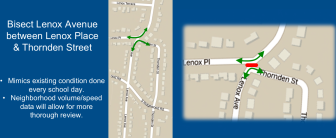
The potential “bisection”
Other potentially workable solutions included a combination of flashing signs and road striping, making the lower block of Lenox Avenue one way, and the use of a 4-way stop sign at the intersection of Lenox Avenue, Lenox Place and Thornden Street.
(See Charles’ full presentation below.)
When commenters took to the microphone, they were polite but adamant in their opposition to the bisection proposal. One asked for a show of hands from those in the room who opposed bisection. All went up save two from the audience; there were approximately 75 people in attendance, not counting the presenters and members of the South Orange Transportation Advisory Committee (SOTAC).
“Lenox Avenue is designed to be a through street,” said Jerry Ryan, an area resident and former Maplewood mayor, who added, “It’s clear to me that the solution belongs at Lenox Avenue and Ridgewood…. Bisection should be rejected. Clearly you do not have people behind you.”
Several residents expressed their appreciation for the work of Charles and his collaborators Mark Grady and Alison McInerney.
However, they also expressed their dissatisfaction with the bisection. A self-described stay-at-home mom from Lenox Place said that she felt the issue was a white fence at the S. Ridgewood intersection that impeded sight lines. “That’s never been discussed. Bisection wouldn’t fix that.” (Grady later explained that this was his fence and he had lowered the height, working with the town.)
Another resident also brought up line of sight, saying there was no evidence that drivers were not stopping at the stop signs. “The most obvious solution is cutting down the hedge and removing the fence,” he said, “then collect the data.”
South Orange Transportation Advisory Committee chair Dan Peterson replied that with such a solution “you won’t know the effect statistically for 5-7 years.”
Another resident questioned how the bisection would affect access by emergency services. Charles noted that the group had included South Orange police and fire personnel in their discussions.
However, South Orange Police Chief Kyle Kroll seemed to undermine the idea of bisection by talking up line-of-sight issues.
“I don’t know about seven years,” said Kroll, referring to Peterson’s comment, “but I’m a big proponent of line of sight.” The Chief noted that police were increasing traffic patrols and were working with Village officials to enforce a new line-of-sight ordinance. Kroll said that the Village was also working to paint curbs yellow within 25 feet of intersections in order to keep cars from parking and obstructing line of sight.
Other commenters wanted the group to pilot other solutions before resorting to bisection. “Rumble strips and stop signs seem to be easy to put up and move,” said one resident, who added that that was the “logical place to start” instead of “cutting off a street.”
Another resident questioned the outreach made by the group. “You’re sequencing is off … you should have gone to other people first.” (The working group pointed out that they had done a number of small neighborhood meetings prior to August 10; however, many residents at the meeting Wednesday night said they had just heard of the effort.)
Local resident Lisa Scheib said that her issue was speed on S. Ridgewood. She said she found it dangerous to cross to Cedar Ridge Cafe with her children and would like to see more police details. However, she noted, “I’m very much against bisection” and said there there were at least 12 young children on her block who would be subjected to increased traffic should the bisection take place.
Another resident said that the Village should not “want self interest to trump public interest” and that it should “bring in independent outside research.”
At least two Lenox Avenue residents defended the work of Charles, McInerney and Grady. One resident of 27 years admonished the crowd, saying that issues of volume and speeding on Lenox Avenue were real and not imagined. She spoke of people “gunning it” down the street and asked her fellow residents not to “lose interest if bisection is off the table.”
Overall, many residents who spoke echoed a desire to increase traffic and pedestrian safety in the area, including on Lenox Avenue, but expressed concerns that piloting the bisection proposal would simply push dangerous conditions onto other streets that were not designed for through traffic. At least two residents spoke about a “blind curve” on Thornden and the lack of sidewalks in certain locations.
Near the end of the meeting, a resident from the audience asked point blank, “Can we say bisection is off the table?”
Charles responded by saying that if other solutions are preferred and could be tested, he was “eager to take that off the table.”
Village Green reached out to Charles to ask definitively if bisection is off the table. In an email, Charles wrote, “We won’t pursue anything that doesn’t have community support, bisection included, and our focus is ensuring that this isn’t the end of the safety improvement effort.” (See Charles’ full email response below.)
At the end of the Wednesday meeting, Trustee Jeff Dubowy, the SOTAC liaison, added, “Bisection looks like it’s not happening.” He outlined the process that any proposals for traffic safety would have to undertake before being implemented — including the need to work with SOTAC, the Board of Trustees, and the Village attorney, engineer and administrator, before any proposal could be drafted as an ordinance at which point it would go through two readings, a hearing and a vote.
“It’s a very democratic process,” said Dubowy.
Neighborhood association organizer and Seton Hall University professor Janine Buckner asked residents to stay engaged, suggesting that they offer to host meetings in their houses or aid in research. “Talk amongst yourselves, make lists, go to meetings … volunteer, expand the data set,” suggested Buckner.
At the back of the room, attendees could sign up to receive a copy of the Lenox Avenue Traffic Study, as well as volunteer. Forty-seven signed the list, with seven checking the box to volunteer.
(Late in the meeting, Trustee Howard Levison brought up the fact that SOTAC had contacted neighborhood associations and compiled a list of dangerous intersections throughout South Orange in order to work toward increasing traffic and pedestrian safety. Village Green will follow up in a separate story.)
Statement from Ron Charles:
“Mark, Alison and I were incredibly grateful for so many of our neighbors to come out last night, and I think everyone shared the feeling that it was a productive night with lots of info and lots of ideas put forth. Prior to the meeting, the reaction to the bisection idea certainly was strong; and we’d like to chalk up neighbor’s concerns about our outreach methods to the fact that the three of us have never previously been involved in politics or community organizing before this effort. We were encouraged by the public comments that gave such strong support for improving the dangerous roadway conditions in the neighborhood, as well as the support for our personal effort to quantify the danger and spend so much of our time doing so. We also appreciate the words of support for ideas such as integrating the FHWA’s Intersection Safety Measures and the interest in possibly adding stop signs on Lenox Ave where it meets with Lenox Place and Thornden Street. We won’t pursue anything that doesn’t have community support, bisection included, and our focus is ensuring that this isn’t the end of the safety improvement effort. If we can harness a fraction of the passion that was in the room last night in an ongoing basis, we’re confident we’ll be able to make changes for the better in our neighborhood that the entire community can get behind.”
Click on photos to enlarge:

